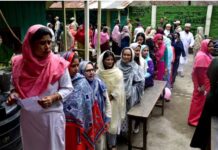There are different economic theories of famine, which have been analysed in the context of 1974 famine in Bangladesh. Let’s discuss demand failure first then we shall move to supply failure.
Causal trigger one: Entitlement collapse (demand failure)
“Failure in effective demand or “entitlement collapse” – the inability of identifiable groups of people to command enough food for subsistence, irrespective of the stock available at local or national level” (Devereux, 2000, page 19).
In terms of victims of the famine, Sen (1981, page 141) presented data which show that “The largest group of destitute in the langarkhanas were labourers (45%), followed closely by framers (39%). If the labourers are split into agricultural and non-agricultural workers, the groups of farmers would appear to be the single largest category”.
 Occupational Distribution of Destitution in Bangladesh, 1974 (Sen, 1981, page 142)
Occupational Distribution of Destitution in Bangladesh, 1974 (Sen, 1981, page 142)
In terms of landownership, “32% had no land at all. Perhaps more importantly, 81% owned less than half an acre of land if they owned any land at all” (Sen, 1981, page 144).
In the same period, “percentage of rural population in extreme poverty was 42.1%” (Sen, 1981, page 152).
“Since the typical destitutes had their endowment only labour power with –at best-little bit of land, the most important part of the entitlement relation to look at is the entitlement based on labour power”. Sen calculated the decline in “Rice-Exchange Rate of Rural Labour during the Bangladesh Famine, 1974” and showed that the decline compared to December 1973 “in the months just preceding the famine and through the famine” was very sharp. In terms of comparison on “the same month previous year based” there was 35%-45% fall in “Rice Exchange Rate”- “for a group of people already close to subsistence” “With that kind of decline in the entitlement to rice, labourers would be pushed firmly towards starvation and death” (Sen, 1981, page 145-147).
“…there was also a decline in absolute money wage rate in a few districts, including the famine district of Mymensingh and Rangpur, between June and October 1974” (Sen, 1981, page 150).
This decline “was clearly reinforced by a decline in employment opportunities in the famine year. Here the floods played a part. …the decline in employment opportunities was immediate” (Sen, 1981, page 147).
Sen concludes that “peak employment takes place in June-August (in terms of normal seasonal pattern of employment in cultivation), and this is of course precisely the time when the floods hit, drastically reducing the scope of employment in cultivation” (Sen, 1981, page 148).
In this regard Osmani (1991, page 328) says — “Loss of employment due to flood clearly played its part in the 1974 famine. Especially significant was the damage to the jute crop, whose production declined by a massive 42%. Jute is one of the most labour intensive crops of Bangladesh agriculture and wage income from its production provides the principal cushion for surviving through the lean season of July-October in jute growing areas. Loss of this cushion was no doubt a crucial factor in precipitating the famine that struck in the lean season”.
However, Devereux (2000, page 20-21) criticizes Sen’s entitlement approach and his view that famine is an “economic disaster” –“It showed us how people might face starvation during famine: it did not tell us why. By choosing to restrict his analysis of famines to the relationship between people and market under stress, Sen perpetuates a technocratic view of famine that excludes politics and intent as causal factor, and political action as an appropriate –even necessary-solution”.
Causal trigger two: International community (supply failure)
Keen (1994:213) viewed famine as a political phenomenon –“The real root of famine lies less in the purchasing power within the market (although it will be one of the mechanisms of famine) than lack of lobbying power within national (and international) institutions”. “…international governments and humanitarian organisations must share responsibility for famine that occur because of failures to respond adequately and promptly to developing food crisis”. He concludes, “Food aid has always been used as a political weapon”.
Famine in Bangladesh in 1974 was “exacerbated by deliberate withholding of relief by the international community” (Devereux, 2000, page 23).
According to Osmani (1991, page 331) IMF was not “generous and prompt” in response to famine conditions in Bangladesh in 1974; he described IMF’s response as “niggardly”. Borrowings under the IMF compensatory financing facility were also meager”, a total of US$74.3 million in 1974. By September and October 1974, monthly imports ranged between 29,000 and 70,000 tons compared to the monthly requirement of 250,000-300,000 tons”. (Islam, 2003, page 223-224)
Bangladesh received only US$10.5 million worth of food aid from World Food Organization, Qatar and Japan; US$50 million loan from World Bank’s International Development Association (IDA) and an in principle agreement from Food and Agriculture Organization (FAO) of the United Nations to provide emergency food aid to counter Bangladesh’s food crisis between August-October 1974 (Miah, 1993, page 204-208).
Local production was not adequate to feed the people of Bangladesh; therefore it was heavily dependent on imported food. However, import was reduced by about 28% in 1974 compared to 1973. “In fact, in the crucial months of September and October the imports fell to a trickle and the amount of food grains imported during these two months, rather than being larger”-reduced by 89% and 74% respectively, compared to those months in the preceding year (Sen, 1981, page 135).
 Import of food grains into Bangladesh, 1973 and 1974 (Sen, 1981, page 135)
Import of food grains into Bangladesh, 1973 and 1974 (Sen, 1981, page 135)
“The attempt by the government to procure food from abroad did not succeed partly because of its own limited foreign exchange resources and partly because of delays in the commitment of aid by the United States. Reserves in the third quarter of 1974 were about 25% of what was in the third quarter of 1973.
“These natural triggers operated in contexts where local economies were weak (subsistence based, imperfectly integrated with wider market) and the political will or logistical capacity to intervene was lacking” (Devereux, 2000, page 13). The newly independent Bangladesh did not find an international community with a helping hand in its moments of trial.
Causal trigger three: Speculators (market/supply failure)
According to Devereux (2000, page 19) flood and market failure were “causal triggers” of the 1974 famine. According to him, this famine “was triggered by alarmist prediction of flood damage to crops that tuned a minor shortfall in rice production into a major shortfall in marketed supplies, so that prices escalated beyond the reach of the market dependent poor (Ravallion 1987)”. This view is supported by other scholars.
“But the floods in July-August 1974 caused not only extensive damage to jute crop, a major source of employment and cash income for the rural population, but more importantly, it adversely affected planting for the next aman and created the fear of a large shortfall in the aman crop…the time was rife for speculation (Islam, 2003, page 222-223).
“Prices started to rise from March 1974 onwards” because “there was a severe reduction in public stocks starting end 1973, which fell by more than half between 1972-73 and early 1974 when it was barley 150,000 tons. A drastic reduction in public distribution, specially the modified rationing system and the relief distribution system, starting January 1974 led to the collapse of confidence in the government’s ability to stabilize price situation in the coming months. There was an upsurge in speculative holding of stocks by farmers, consumers and traders in anticipation of future scarcities” (Islam, 2003, page 223).
“What explains such disproportionate movements in the price of foodgrain? Certainly not the size of its availability. Nor it can be explained by general inflationary forces such as expansion of money supply (Ravallion 1985, Ahmad 1985). Ravalion (1985) has also shown that the dramatic price increase of 1974 can be neatly explained by the speculative behaviour of rice traders. Exaggerated (media) reports of crop damage led the traders to overestimate future scarcity. The resulting overshooting of future price expectations caused “excessive hoarding” and hence the abnormal increase in current price” (Osmani, 1991, page 329).
However, only overestimation of crop damage may not explain the skyrocketing of foodgrain price in 1974. Ravallion (1985) concludes that “The most plausible conclusion is that the stock-holders’ over-optimistic price expectations and/or anticipations of future rationing during the 1974 famine were premised on a belief that the Government would be unable to implement a suitable stabilizing response to the reported damage to the future crop. Belief in the ability of the government’s Public Food Distribution System (PFDS) to deal with an emergency crisis seems indeed to be crucial” (Osmani, 1991, page 329).
“It has been well documented that the public stock of foodgrain was very low in 1974 and the government’s capacity to import was also very limited due to an unfavourable aid climate on the one hand and dwindling foreign exchange reserves on the other (Alamgir 1980, Sen 1981, Ahmad 1985). This was no secret and the speculators were obviously aware of the predicament” (Osmani, page 330).
We shall discuss aggravating factors in the last instalment.











the great one misjudged his magic. He was flying in the sky. While his family was looting the country, the people suffered. While he was in a first class jail, the country suffered. He is now our father of the nation whether we like it or not. He was killed by a few decorated freedom fighters because he ran the country amock. A poor ruler and power hungry corrupted one. The history will be re-written when we become more stable and mature. Specially when these two ladies die. They have ruined this country in the name of their father or husband.
And history will be rewritten when people like you also die too along with these two ladies! Because your judgement of character and events is almost idiotic!
I fully agree with Mr. Hossain’s observations. Bangladesh indeed needs a truthful history written mainly to get people to know and appreciate what exactly had happened and why, so that we get to learn from our mistakes and at the same time, derive inspirations from truthful glorious accomplishments.
Now coming back to the 1974 famine, not only that in spite of repeated warnings of the experts of the ensuing famine that the then government did virtually nothing to take required precautionary measures, their especially its leadership’s total lack of empathy to the miseries of starving millions was, to say the least, utterly inhuman. At a time time when people were dying (literally) outside the Gonobhaban (then the official residence of the then Prime Minister), its occupant was holding with vulgar glee an ostentatious feast to celebrate his son’s wedding. Rest is all history – as Faiz Ahmed Faiz once said, the throne of the oppressor shakes and flies like a piece of cotton at peoples’ wrath!
It’s very fascinating that those who had not even been born before 1971 want to teach us the history of the liberation war and independent Bangladesh. What do these stupid people know of the real history of the war of independence? Only hearsay? Tale-tell? We are not only eye-witnesses but more or little had the good fortune to work for the country during that period of grave crisis. They come to teach us history. How foolish! We know those who claim to be ‘chetanadhari’ while being almost ‘ochetan’ (dead drunk) even in daytime. But most unfortunately, the greater bulk of those who fought for the country, unfed, underfed and almost bare-bodied, have been forgotten and the 16th-divisioners have usurped the benefit of liberation to their utmost. But truth prevails in the long run. It must come out sooner or later. Just wait.